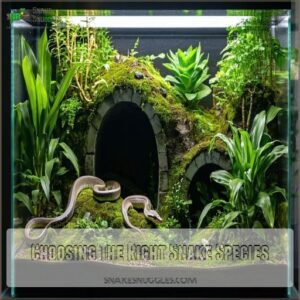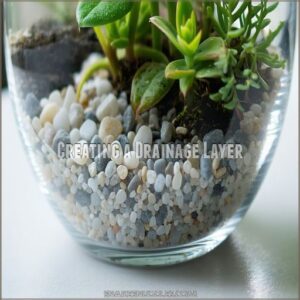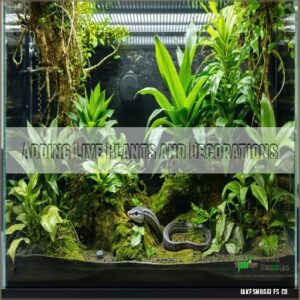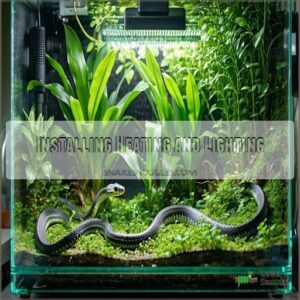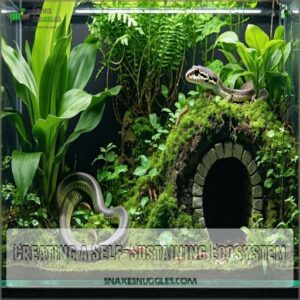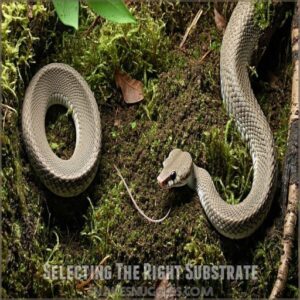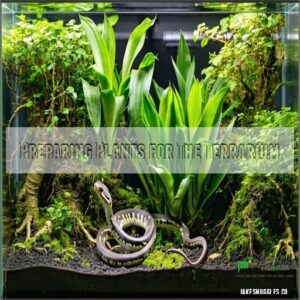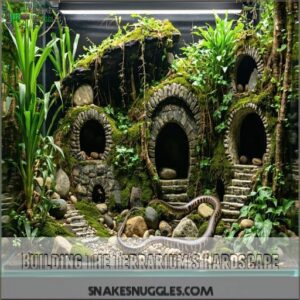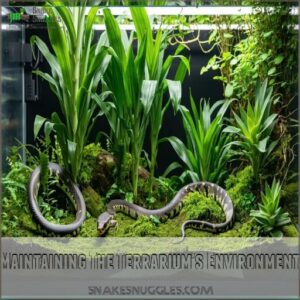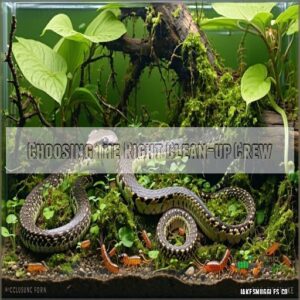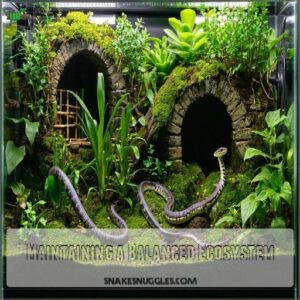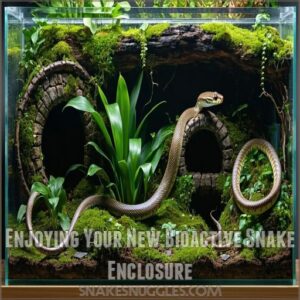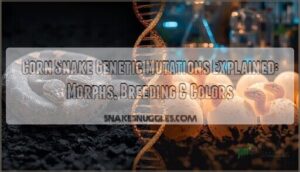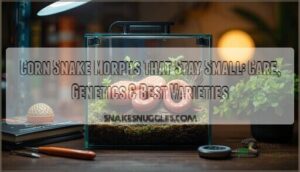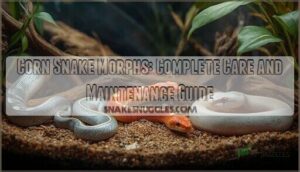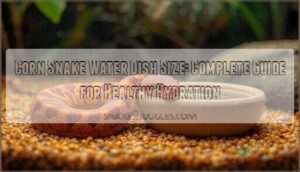This site is supported by our readers. We may earn a commission, at no cost to you, if you purchase through links.
 Creating a corn snake bioactive enclosure is like building a small jungle with natural charm and smart design.
Creating a corn snake bioactive enclosure is like building a small jungle with natural charm and smart design.
Start with a drainage layer of clay pebbles (LECA), then top it with 4–6 inches of bioactive substrate—think a mix of topsoil, peat moss, and coconut coir.
Add live plants like pothos or snake plants for cover and humidity control. Introduce springtails and isopods as your cleanup crew—they’ll handle waste like pros.
Don’t forget the essentials: a thermostat-controlled heat mat, UVB lighting, and a temperature gradient (75-95°F). Maintain humidity around 50%, and watch your clean, self-sustaining habitat shine—low maintenance, big payoff!
Table Of Contents
- Key Takeaways
- Choosing The Right Snake Species
- Setting Up The Terrarium
- Creating a Self-Sustaining Ecosystem
- Selecting The Right Substrate
- Adding Live Plants to The Terrarium
- Building The Terrarium’s Hardscape
- Maintaining The Terrarium’s Environment
- Choosing The Right Clean-up Crew
- Maintaining a Balanced Ecosystem
- Enjoying Your New Bioactive Snake Enclosure
- Frequently Asked Questions (FAQs)
- How do I create a bioactive corn snake vivarium?
- Are bioactive substrates good for corn snakes?
- How do you choose a bioactive enclosure for a snake?
- How do you care for a corn snake?
- Do corn snakes need enclosures?
- How big should a corn snake enclosure be?
- Can a corn snake live in a bioactive enclosure?
- How to setup a bioactive corn snake tank?
- What is the best clean up crew for corn snakes?
- How active should my corn snake be?
- Conclusion
Key Takeaways
- Start with a drainage layer, bioactive substrate, and live plants like pothos or snake plants to create a natural and self-sustaining environment.
- Add a cleanup crew of springtails and isopods to manage waste, prevent mold, and maintain substrate health.
- Maintain a temperature gradient of 70–95°F and humidity levels between 40–60%, using a heat mat, thermostat, and UVB lighting.
- Provide your snake with hides, climbing structures, and a balanced ecosystem to support natural behaviors and stress-free living.
Choosing The Right Snake Species
If you’re setting up a bioactive enclosure, choosing the right snake species can make or break your habitat’s success.
You’ll want to take into account corn snakes, ball pythons, or western hognose snakes, each bringing unique characteristics that can thrive in a carefully constructed, naturalistic environment.
Ball Pythons as a Good Choice
If you’re diving into reptile husbandry, ball pythons might just be your perfect companion.
These gentle giants bring a calm temperament that makes them ideal for both beginners and experienced keepers.
Their manageable size and relatively low-stress housing needs make them excellent candidates for a corn snake bioactive enclosure.
They’re adaptable, docile, and surprisingly easy to care for in the right environment.
When choosing ball pythons, consider the importance of temperament affects ease of handling, as this will directly impact your interaction with your pet snake.
Corn Snakes and Their Adaptability
After exploring ball pythons, corn snakes emerge as a top-tier choice for your bioactive enclosure adventure.
Their adaptable corn snake temperament makes them perfect for beginners and seasoned reptile lovers.
With impressive humidity tolerance and dietary flexibility, these slithery companions thrive in carefully crafted environments.
For a thriving bioactive setup, proper corn snake enclosure planning is key.
Their easygoing nature means your bioactive enclosure setup can be both comfortable and fascinating.
Western Hognose Snakes and Their Quirks
While corn snakes offer easy-going vibes, western hognose snakes bring a whole different personality to your bioactive enclosure.
These drama queens of the reptile world sport unique defensive behaviors that’ll keep you entertained.
Their quirky temperament means specialized habitat setup is key – think carefully placed hides and a terrain that matches their dramatic flair for survival.
Setting Up The Terrarium
You’ll transform your corn snake’s living space into a thriving, naturalistic habitat by carefully setting up a bioactive terrarium.
With the right drainage layer, substrate, live plants, and heating elements, you’ll create an environment that mimics your snake’s native ecosystem.
and promotes its health and well-being.
Creating a Drainage Layer
You’ve picked your corn snake, and now it’s time to build its dream home.
The drainage layer is your terrarium’s unsung hero, preventing waterlogging and keeping your snake’s habitat healthy.
Use clay pebbles or lightweight expanded clay aggregate (LECA) to create a 1-2 inch barrier between the substrate and bottom of the enclosure, ensuring moisture control and root health for your bioactive setup.
Selecting a Bioactive Substrate
Your drainage layer sets the stage for an epic substrate adventure.
The perfect bioactive corn snake substrate is a carefully crafted soil mix that’s part science, part art.
Aim for 2.5-8 inches deep, blending organic topsoil, peat moss, and coconut coir to create a moisture-controlling masterpiece that’ll make your snake feel right at home in its mini ecosystem.
Adding Live Plants and Decorations
A social media graphic depicting a bioactive terrarium for a corn snake.
The terrarium is densely planted with pothos, snake plants, and bromeliads, creating a lush, natural environment with numerous hiding places. The plants are highly detailed, showing individual leaves, textures, and variations in color.
The substrate is realistically textured, with visible moisture and organic matter.
The corn snake itself is subtly incorporated, perhaps partially hidden within the foliage, emphasizing the natural integration of the snake into its environment.
The lighting is soft and diffused, mimicking natural sunlight filtering through foliage. The overall aesthetic is one of vibrant, healthy, and naturalistic detail, highlighting the enriching environment provided for the snake.
Installing Heating and Lighting
After nestling your live plants into the terrarium, it’s time to create the perfect temperature and lighting scenario for your slithery friend.
A heat mat strategically placed under one side of the enclosure will establish that essential temperature gradient.
Pair it with a reliable thermostat, and add a UVB light to mimic natural cycles in your corn snake’s bioactive paradise.
Creating a Self-Sustaining Ecosystem
You’re about to transform your corn snake’s habitat into a living, breathing ecosystem that mimics nature’s intricate balance.
By introducing springtails, isopods, and strategic biodegradables, you’ll create a self-sustaining environment.
This self-sustaining environment supports your snake’s health and enriches its daily experience.
Introducing Springtails and Isopods
Once your corn snake bioactive enclosure takes shape, it’s time to bring in the microscopic cleanup crew.
Springtails and isopods are nature’s tiny maintenance workers, transforming waste and keeping your habitat pristine.
These small but mighty organisms manage population control, break down organic matter, and prevent growth – making them superstars in species selection for long-term care.
When selecting plants like Golden Pothos, consider their role in creating a self-sustaining ecosystem.
Adding Biodegradables and Fungi
Fungi and biodegradables are the unsung heroes of a thriving corn snake bioactive substrate. They transform your terrarium into a living ecosystem that mimics natural forest floors.
Key components include:
- Diverse leaf litter types for breakdown
- Nutrient-rich bark fragments
- Organic matter supporting microbial life
These biodegradable elements create a dynamic substrate that enhances your corn snake’s habitat, promoting natural behaviors and maintaining a balanced, self-sustaining environment.
Maintaining Temperature and Humidity Gradients
Your corn snake‘s comfort hinges on nailing that temperature gradient like a pro.
To achieve ideal heat distribution, consider investing in a high-quality corn snake heat mat.
In your bioactive enclosure, create a thermal range from 70-75°F on the cooler end to 90-95°F on the warmer side.
Use heat mats, thermostats, and strategic ventilation to maintain consistent humidity levels between 40-60%, mimicking the snake’s natural southeastern habitat.
Selecting The Right Substrate
When creating the perfect habitat for your corn snake, you’ll want to choose a substrate that mimics their natural southeastern US environment.
Your substrate mix should provide moisture, support burrowing, and create a healthy ecosystem.
That’ll make your snake feel right at home.
Ingredients for a Bioactive Substrate
When creating the perfect corn snake bioactive substrate, you’ll want to mix ingredients that mimic their natural habitat.
Here’s your roadmap to crafting the foundation:
- 40% organic topsoil (pesticide-free)
- 30% peat moss for moisture retention
- 20% fine sand for drainage
- 10% clay for structure
- Leaf litter for natural decomposition
Blend these components carefully, and you’ll build a thriving ecosystem that feels like home.
Choosing The Right Depth
Build your corn snake bioactive enclosure with precision by hitting that sweet spot in substrate depth.
Aim for 3-4 inches—just right for your slithery friend’s burrowing adventures.
This depth range lets your snake feel secure while maintaining perfect humidity.
Too shallow, and you’ll cramp their style; too deep, and you’ll create a moisture nightmare.
The Importance of Biodegradables
When sizing up substrate depth, biodegradables become your secret weapon for a thriving corn snake bioactive enclosure.
These natural materials spark a microscopic revolution in soil health and ecosystem balance.
Consider adding:
- Leaf litter for waste breakdown
- Bark pieces supporting natural cycles
- Wood chips enriching habitat complexity
Biodegradables transform your terrarium from a simple enclosure into a living, breathing environment that mimics your snake’s natural world.
Adding Live Plants to The Terrarium
You’ll transform your corn snake’s habitat into a living, breathing ecosystem by strategically adding live plants.
These carefully selected snake-safe plants create a more visually appealing terrarium.
live plants provide essential hiding spots and natural enrichment. snake-safe plants also help regulate the environment and give your scaly friend a more dynamic and stimulating environment.
Benefits of Live Plants for Snakes
If you’re looking to level up your corn snake’s home, live plants aren’t just pretty decorations – they’re game-changers for humidity regulation and stress reduction.
These green companions create natural hiding spots, boost enrichment, and transform your corn snake bioactive enclosure into a miniature ecosystem that mimics their wild habitat.
They’re basically a snake’s five-star resort.
Choosing The Right Plants for Your Biome
After exploring the benefits live plants bring to your snake’s habitat, let’s zero in on plant selection for your corn snake’s bioactive enclosure.
When choosing plants, also consider the unique needs of your snake’s climate, such as a tropical or arid environment.
Your green companions must pass three key tests:
- Plant safety (no toxic varieties)
- Growth rate compatibility
- Space requirements matching your enclosure
Pick snake-friendly plants that create a natural, stress-free environment without overwhelming your slithery friend.
Preparing Plants for The Terrarium
Now that you’ve picked the perfect bioactive plants for your corn snake enclosure, it’s time to get them ready for their new home.
Carefully wash each plant to remove potential pesticides and hidden pests.
Quarantine new additions for a week, inspecting thoroughly for any unwelcome hitchhikers.
Gently remove excess soil, trim damaged roots, and prepare for a smooth acclimation to your snake’s paradise.
Building The Terrarium’s Hardscape
You’ll transform your corn snake’s habitat into a naturalistic wonderland by strategically placing wood, rocks, and decorative elements that mimic their native southeastern woodland environment.
Your hardscape isn’t just about looks—it’s about creating a functional landscape.
multiple hiding spots, climbing opportunities, and secure spaces where your snake can feel completely at home are provided.
Using Wood and Rock in The Terrarium
When crafting your corn snake bioactive enclosure, wood and rock selections become the backbone of a natural habitat.
Choose untreated, pesticide-free branches and rocks that create secure hiding spots while mimicking your snake’s native environment.
Position larger pieces strategically to provide climbing opportunities and shelter, ensuring each element contributes to a safe, stimulating landscape for your slithery friend. Wood and rock selections are important for a bioactive enclosure.
Adding Decorations and Hides
Rock textures and wooden structures set the stage for your corn snake’s hiding haven.
Your bioactive enclosure needs smart decoration choices that blend safety and style.
Here are five key hide types for your terrarium:
- Cork bark rounds
- Ceramic cave structures
- Driftwood tunnels
- Natural stone shelters
- Hollow log hideaways
Strategically placed decorations provide your slithery friend with security and exploration opportunities.
Placing The Hardscape for Optimal Use
Strategic hardscape placement transforms your corn snake’s bioactive enclosure from ordinary to extraordinary.
Position hide boxes at different temperature zones, ensuring your slithery friend can regulate body heat effortlessly.
Arrange climbing structures near vertical surfaces, creating a landscape that mimics natural woodland terrain and maximizes space utilization while providing visual appeal and security.
Maintaining The Terrarium’s Environment
You’ll need to become a vigilant caretaker of your corn snake’s bioactive terrarium, monitoring key environmental factors like temperature and humidity with precision.
Your success hinges on consistent observation, strategic watering, and thoughtful plant maintenance to create a thriving, balanced ecosystem for your slithery companion.
Monitoring Temperature and Humidity
Your climate control dashboard—a digital thermometer and hygrometer—are your best friends in a corn snake bioactive enclosure.
Precision matters when tracking temperature fluctuations and humidity control.
Aim for 70-75°F on the cooler end and 90-95°F on the warmer side. Keep humidity between 40-60%, using these monitoring tools to catch and troubleshoot potential environmental issues before they become serious problems.
Watering and Misting The Terrarium
After tracking humidity like a hawk, you’ll want to master watering your corn snake’s bioactive enclosure. Distilled water is your best friend for misting and maintaining excellent humidity levels.
Watering checklist:
- Use room-temperature distilled water
- Mist gently to avoid oversaturating
- Target 50-70% humidity for corn snake bioactive setup
- Check soil moisture with your fingertip
- Adjust frequency based on substrate and plant needs
Pruning Live Plants and Replacing Decorations
With pruning shears in hand, maintain your corn snake bioactive enclosure’s plant health by trimming dead or overgrown foliage.
Remove wilted leaves and shape plants to prevent overcrowding.
Swap out decorations every few months, cleaning artificial decor thoroughly.
Your refresh schedule keeps the bioactive enclosure looking vibrant and maintains a natural habitat for your slithery friend.
Choosing The Right Clean-up Crew
You’ll want a clean-up crew that transforms your corn snake’s habitat into a self-maintaining ecosystem, breaking down waste and keeping things fresh.
Springtails and isopods are your tiny, hardworking partners.
Springtails and isopods will help manage moisture, control mold, and maintain a balanced environment for your slithery friend.
Springtails and Isopods for Waste Management
Keeping your corn snake’s bioactive enclosure spotless isn’t rocket science—springtails and isopods are your microscopic maintenance heroes. These tiny cleanup warriors tackle waste like pros, turning potential mess into an efficient ecosystem.
Here’s how they work their magic:
- Consume decaying organic matter
- Break down snake waste rapidly
- Prevent harmful bacteria growth
- Maintain substrate cleanliness
These industrious invertebrates transform your enclosure into a self-cleaning marvel.
Fungi and Other Organisms for Breakdown
As springtails tackle surface waste, fungi take center stage in breaking down organic matter within your corn snake bioactive enclosure.
These microscopic powerhouses work underground, cycling nutrients and maintaining microbial balance.
Different fungal species decompose fallen leaves, bark, and other biodegradables, transforming waste into rich, living substrate that supports your snake’s ecosystem health.
Introducing The Clean-up Crew to The Terrarium
After your bioactive terrarium takes shape, carefully introduce your cleanup crew of springtails and isopods.
These tiny invertebrates are your ecosystem’s maintenance team, breaking down waste and keeping your corn snake’s bioactive enclosure pristine.
Start by gently sprinkling them across different substrate areas, ensuring they’ve initial food sources like leaf litter and decaying organic matter.
Maintaining a Balanced Ecosystem
Creating a balanced ecosystem for your corn snake isn’t just about throwing in some plants and critters—it’s a careful science.
This carefully crafted habitat will keep your slithery friend happy and healthy.
You’ll need to monitor your terrarium’s environment closely, making gradual adjustments.
These adjustments should mimic nature’s delicate rhythms without shocking your snake’s carefully crafted habitat.
Avoiding Dramatic Changes
Your clean-up crew just settled in, and now it’s time to play it cool with your corn snake bioactive enclosure. Dramatic shifts can send your ecosystem into a tailspin, so take it slow and steady. Patience is your best friend when creating a habitat.
Maintaining a temperature gradient, with a basking spot temperature around 90°F, is essential for your snake’s health, so facilitate a smooth integration when introducing new elements.
- Avoid sudden temperature changes
- Introduce new elements gradually
- Minimize handling during ecosystem establishment
- Watch for subtle environmental shifts
- Move decorations with gentle precision
Monitoring The Terrarium’s Health
Watch your corn snake bioactive enclosure like a hawk.
Regular temperature checks, tracking humidity levels, and observing plant health are your first line of defense.
Scan for waste buildup, monitor your snake’s behavior, and keep an eye on the entire ecosystem.
These quick daily checks prevent small issues from becoming big problems in your bioactive terrarium. This is crucial for corn snake health.
Making Adjustments as Needed
Keeping your corn snake bioactive enclosure humming smoothly means staying alert to subtle shifts. Small changes can make a big difference in maintaining a thriving ecosystem.
Here’s how to keep your corn snake’s home in tip-top shape:
- Monitor substrate depth for ideal moisture
- Make gentle humidity tweaks
- Check plant health regularly
- Balance your cleanup crew population
- Respond to temperature shifts quickly
Mastering these adjustments guarantees your snake’s habitat remains a living, breathing environment.
Enjoying Your New Bioactive Snake Enclosure
Watching your corn snake explore its bioactive enclosure is both fascinating and rewarding.
You’ll notice natural behaviors like burrowing, climbing, and hiding, giving you a glimpse into its wild instincts.
Observing Your Snake’s Behavior
A corn snake’s activity levels and basking habits can reveal plenty about its overall health.
Notice how it explores the bioactive enclosure, especially during the evening when it’s most active.
A strong feeding response and smooth shedding process signal proper snake care. Consistently observing these behaviors helps you understand animal behavior while ensuring your snake thrives in its habitat. A strong feeding response and smooth shedding process are key indicators.
Enjoying The Benefits of a Bioactive Terrarium
A bioactive enclosure for a corn snake offers so many perks! From reduced cleaning and lower odors to the natural beauty of a thriving ecosystem, it’s a win for you and your snake. Watch your corn snake enjoy enrichment like burrowing and exploring.
- Natural waste breakdown reduces maintenance.
- Plants create humidity balance.
- Lower odors due to cleanup crew.
- Aesthetic appeal of live plants.
Continuing to Learn and Improve
Growth never stops, especially with advanced setups.
Explore community forums for expert advice and problem-solving tips.
Consider future upgrades, like tweaking your bioactive corn snake enclosure size or enhancing the ecosystem.
Regularly maintaining humidity levels between 40-70% using a hygrometer and misting techniques can help create a thriving environment.
This corn snake bioactive enclosure guide is just the start. Regular corn snake bioactive maintenance makes lasting success possible and lets you enjoy all the corn snake bioactive benefits.
Frequently Asked Questions (FAQs)
How do I create a bioactive corn snake vivarium?
Start with a spacious tank, layer drainage and bioactive substrate.
Add snake-safe plants, hides, and cleanup crew (springtails, isopods).
Maintain temperature, humidity, basic lighting cycles, and monitor regularly for a thriving, self-sustaining ecosystem.
Are bioactive substrates good for corn snakes?
Bioactive substrates work great for corn snakes, creating a natural, self-sustaining environment.
They support burrowing, moisture control, and waste breakdown.
With the right mix and cleanup crew, you’ll watch your snake thrive in a dynamic habitat. This makes for a great bioactive substrate.
How do you choose a bioactive enclosure for a snake?
Pick an enclosure that fits your snake’s size.
It should allow for easy heating and lighting setup and have good ventilation.
Make certain it’s escape-proof and deep enough for substrate layering to support plants and burrowing.
How do you care for a corn snake?
Caring for a corn snake is like curating a living artwork.
Provide a secure enclosure.
Maintain a warm gradient (70-95°F).
Clean regularly.
Feed appropriately-sized prey.
Monitor humidity.
Offer enrichment like hides and climbing spots.
Do corn snakes need enclosures?
Yes, corn snakes absolutely need an enclosure.
It keeps them safe, provides a controlled environment for temperature and humidity, and offers space to explore.
Without it, they’d struggle to thrive or even survive.
How big should a corn snake enclosure be?
Aim for a minimum enclosure size of 40 gallons (36”x18”x18”) for an adult corn snake.
Bigger is always better—larger enclosures offer more room for natural behaviors like climbing, burrowing, and exploring.
Can a corn snake live in a bioactive enclosure?
Imagine a miniature forest where nature takes care of itself—that’s a bioactive enclosure.
Your corn snake thrives here, surrounded by live plants, burrowing soil, and cleanup critters.
Creating a healthy, low-maintenance, and natural habitat.
How to setup a bioactive corn snake tank?
Start with a well-ventilated terrarium, add a drainage layer, bioactive substrate, and cleanup crew.
Choose snake-safe plants, maintain proper temperature gradients and humidity.
Include hiding spots, climbing decor, and a secure lid.
What is the best clean up crew for corn snakes?
Springtails and isopods are the best cleanup crew for your corn snake.
They handle waste, control mold, and help maintain the enclosure’s balance.
Choose species like dwarf white or powder orange isopods for efficient cleanup. Corn snake enclosure maintenance is improved with these species.
How active should my corn snake be?
Your corn snake should be moderately active, exploring its enclosure, especially during twilight hours, but also resting often.
Consistent hiding or extreme activity might signal stress, improper temperatures, or other issues needing attention.
Conclusion
Picture your corn snake bioactive enclosure as a finely tuned orchestra, where every piece—plants, substrate, and cleanup crew—works together in harmony.
By crafting this self-sustaining ecosystem, you’ve created a space that mimics nature, keeps maintenance simple, and enhances your snake’s well-being.
From selecting the right plants to balancing humidity and heat, you’ve built more than a habitat—you’ve crafted a living masterpiece.
Embrace the process, enjoy the rewards, and keep perfecting your setup—it’s a journey worth taking.

